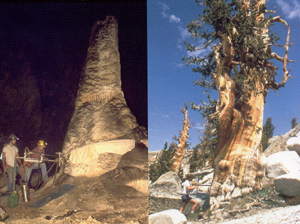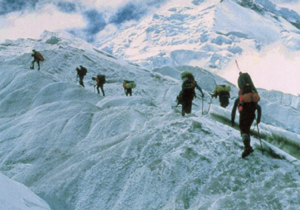 |
| Coral reefs are sensitive to a variety of environmental changes. Smithsonian astronomers Willie Soon and Sallie Baliunas reviewed more than 200 studies of coral, glacier ice cores, tree rings and other indicators to trace changes in the world's climate over the past millennium. They found that the 20th century is NOT the warmest of the past 1000 years. (Credit: David A. Aguilar, Harvard-Smithsonian Center for Astrophysics) |
11:30 a.m., April 15, 2003--A review of more than 200 climate studies led by researchers at the Harvard-Smithsonian Center for Astrophysics has determined that the 20th century was neither the warmest century nor the century with the most extreme weather of the past 1,000 years.
The review, which included work by David R. Legates, director of the University of Delaware’s Center for Climatic Research, also confirmed that the Medieval Warm Period of 800 to 1300 A.D. and the Little Ice Age of 1300 to 1900 A.D. were worldwide phenomena not limited to the European and North American continents.
Legates said the paper argues against a recently espoused view formulated by Michael Mann of the University of Virginia and his colleagues that global air temperatures remained fairly constant from 1000-1900 A.D., then increased dramatically in the 20th century.
“Although [Mann’s work] is now widely used as proof of anthropogenic global warming, we’ve become concerned that such an analysis is in direct contradiction to most of the research and written histories available,” Legates said. “Our paper shows this contradiction and argues that the results of Mann…are out of step with the preponderance of the evidence.”
According to the paper, while 20th-century temperatures are much higher than in the Little Ice Age period, many parts of the world show the medieval warmth to be greater than that of the 20th century.
Smithsonian astronomers Willie Soon and Sallie Baliunas, with co-authors Legates and Craig Idso and Sherwood Idso of the Center for the Study of Carbon Dioxide and Global Change, compiled and examined results from more than 240 research papers published by thousands of researchers over the past four decades. Their report, covering a multitude of geophysical and biological climate indicators, provides a detailed look at climate changes that occurred in different regions around the world over the last 1,000 years.
“Many true research advances in reconstructing ancient climates have occurred over the past two decades,” Soon said, “so we felt it was time to pull together a large sample of recent studies from the last five to 10 years and look for patterns of variability and change. In fact, clear patterns did emerge showing that regions worldwide experienced the highs of the Medieval Warm Period and lows of the Little Ice Age, and that 20th-century temperatures are generally cooler than during the medieval warmth.”
Soon and his colleagues concluded that the 20th century is neither the warmest century over the last 1,000 years, nor is it the most extreme. Their findings about the pattern of historical climate variations will help make computer climate models simulate both natural and man-made changes more accurately, and lead to better climate forecasts especially on local and regional levels. This is especially true in simulations on timescales ranging from several decades to a century.
 |
| Studies of stalagmites (left) and tree rings (right) can yield yearly records of temperature and precipitation trends. Researchers drill small cores to obtain samples. (Credit: Photo on left by Brooks Ellwood, LSU. Photo on right by Tony C. Caprio, NPS.) |
Historical cold, warm periods verified
Studying climate change is challenging for a number of reasons, not the least of which is the bewildering variety of climate indicators–all sensitive to different climatic variables, and each operating on slightly overlapping yet distinct scales of space and time. For example, tree ring studies can yield yearly records of temperature and precipitation trends, while glacier ice cores record those variables over longer time scales of several decades to a century.
Soon, Baliunas and colleagues analyzed numerous climate indicators including: borehole data; cultural data; glacier advances or retreats; geomorphology; isotopic analysis from lake sediments or ice cores, tree or peat celluloses (carbohydrates), corals, stalagmite or biological fossils; net ice accumulation rate, including dust or chemical counts; lake fossils and sediments; river sediments; melt layers in ice cores; phenological (recurring natural phenomena in relation to climate) and paleontological fossils; pollen; seafloor sediments; luminescent analysis; tree ring growth, including either ring width or maximum late-wood density; and shifting tree line positions plus tree stumps in lakes, marshes and streams.
“Like forensic detectives, we assembled these series of clues in order to answer a specific question about local and regional climate change: Is there evidence for notable climatic anomalies during particular time periods over the past 1,000 years?” Soon said. “The cumulative evidence showed that such anomalies did exist.”
The worldwide range of climate records confirmed two significant climate periods in the last thousand years, the Little Ice Age and the Medieval Warm Period. The climatic notion of a Little Ice Age interval from 1300 to1900 A.D. and a Medieval Warm Period from 800 to 1300 A.D. appears to be rather well-confirmed and wide-spread, despite some differences from one region to another as measured by other climatic variables like precipitation, drought cycles, or glacier advances and retreats.
“For a long time, researchers have possessed anecdotal evidence supporting the existence of these climate extremes,” Baliunas said. “For example, the Vikings established colonies in Greenland at the beginning of the second millennium that died out several hundred years later when the climate turned colder. And in England, vineyards had flourished during the medieval warmth. Now, we have an accumulation of objective data to back up these cultural indicators.”
 |
| Glacier ice cores record temperature and precipitation trends over longer time scales of several decades to a century. (Credit: Lonnie Thompson, Byrd Polar Research Center, The Ohio State University) |
The different indicators provided clear evidence for a warm period in the Middle Ages. Tree ring summer temperatures showed a warm interval from 950 A.D. to 1100 A.D. in the northern high latitude zones, which corresponds to the “Medieval Warm Period.” Another database of tree growth from 14 different locations over 30-70 degrees north latitude showed a similar early warm period. Many parts of the world show the medieval warmth to be greater than that of the 20th century.
The study–funded by NASA, the Air Force Office of Scientific Research, the National Oceanic and Atmospheric Administration, and the American Petroleum Institute–will be published in the Energy and Environment journal. A shorter paper by Soon and Baliunas appeared in the Jan. 31 issue of the Climate Research journal.
|

